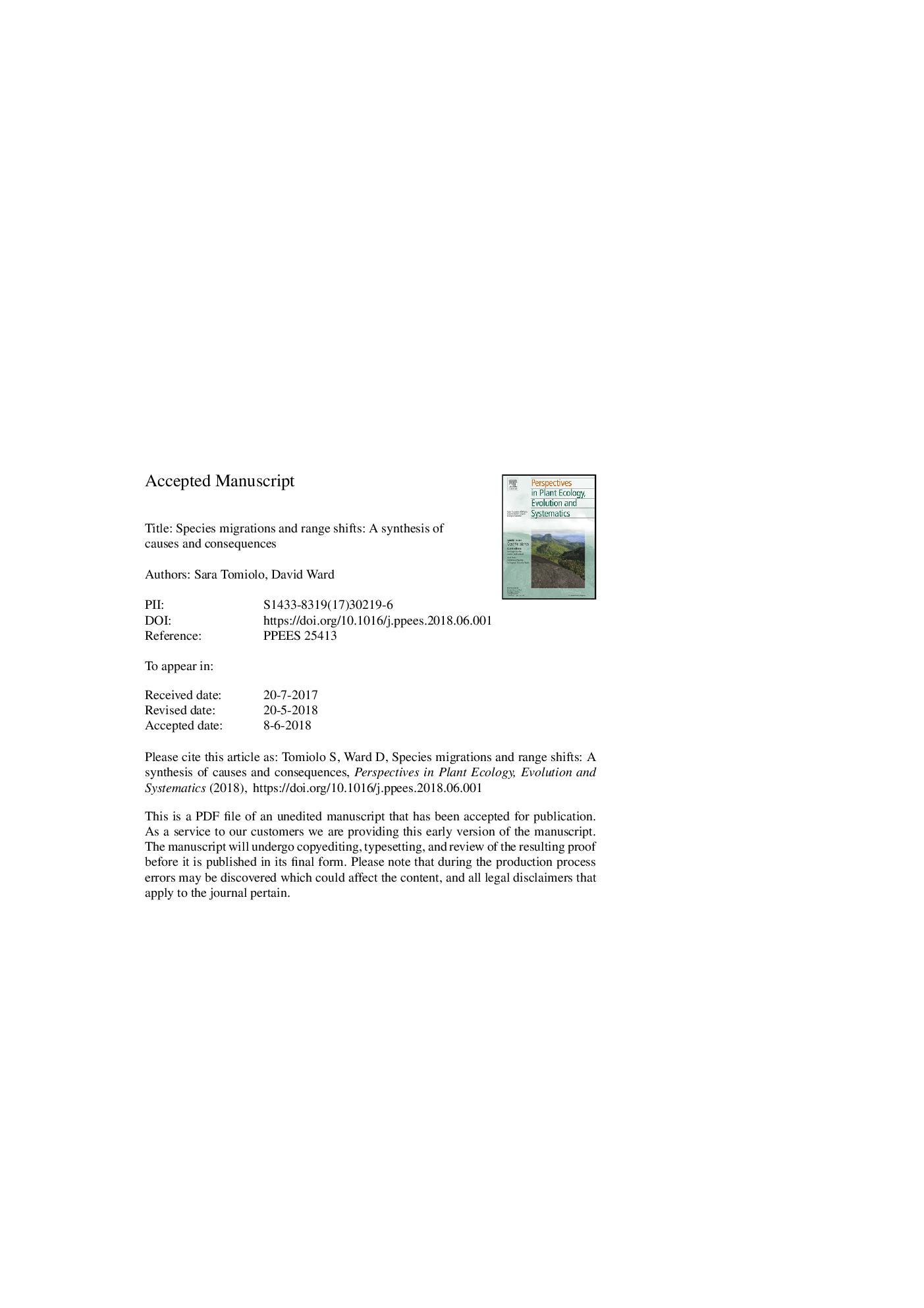| کد مقاله | کد نشریه | سال انتشار | مقاله انگلیسی | نسخه تمام متن |
|---|---|---|---|---|
| 8849481 | 1618587 | 2018 | 81 صفحه PDF | دانلود رایگان |
عنوان انگلیسی مقاله ISI
Species migrations and range shifts: A synthesis of causes and consequences
ترجمه فارسی عنوان
مهاجرت گونه ها و تغییرات دامنه: تلفیق علل و پیامدها
دانلود مقاله + سفارش ترجمه
دانلود مقاله ISI انگلیسی
رایگان برای ایرانیان
کلمات کلیدی
گسترش دامنه، مهاجرت گونه، آب و هوا، تحریم، تعاملات زیستی، پراکندگی،
ترجمه چکیده
در محیط هایی که به طور فزاینده ای تغییر می کند، گونه های گیاهی مجبور به انطباق با شرایط جدید می شوند یا دامنه های خود را تغییر می دهد تا آنها را شناسایی کند. گونه هایی که می توانند طاقچه آنها را با موفقیت پیگیری کنند، ممکن است خطر انقراض را به حداقل برسانند. با این حال، استقرار گونه های جدید در جوامع دریافت کننده منجر به بازسازی و تغییرات زیستی جدید خواهد شد. در حال حاضر، ما درک محدودی از این که چگونه این فرآیند بر جوامع و اکوسیستم ها تاثیر می گذارد. در این بررسی ما دانش فعلی را در مورد گونه های گسترش دامنه سنتز می کنیم. ما با در نظر گرفتن بسیاری از اصطلاحات مورد استفاده برای توصیف جنبه های مختلف گسترش محدوده، مانند مهاجران بومی، مهاجمین، و گونه های مهاجم در داخل قاره شروع می کنیم. پس از آن ما عوامل موثر بر گسترش دامنه ها و تاثیرات بر جوامع دریافت کننده و در سطح اکوسیستم را توصیف می کنیم. تحقیقات ما نشان می دهد که، همانند تحقیق در مورد تجاوزات بیولوژیکی، دانش فعلی در مورد گسترش دامنه ها بسیار متمرکز است و اغلب مطالعات در اروپا و آمریکای شمالی است. بخش بزرگی از تحقیقات در دسترس درختان و درختچه ها و بیشترین زیستگاه های تحقیقاتی، علف های هرز، صخره ها و زیستگاه های بلند است. یکی از دلایل احتمالی چنین تحلیلی این است که گستردگی محدوده بسیاری از گونه های گیاهی (به ویژه آن دسته از گونه هایی که برای کشاورزی مهم نیستند) ممکن است ناشناخته باشد. یکی دیگر از یافته های مهم این است که همان عامل ممکن است بر اساس زیستگاه، شکل زندگی، مقیاس فضایی و زمانی که در آن روند مطالعه مورد بررسی قرار می گیرد، ترویج و یا مانع گسترش دامنه می شود. در نهایت، در حالی که بسیاری از گسترش محدوده ها منجر به تأثیرات منفی بر تنوع زیستی و پایداری جامعه می شود، برخی از آنها اثرات مثبت دارند (مثلا منگور). اگر چه مطالعات بیشتری در مورد اثرات گسترش دامنه در جوامع دریافت کننده تحقیق شده است، تحقیقات ما نشان می دهد که هنوز دانش محدودی از چنین فرآیندهای وجود دارد. تلاش های آینده باید رویکردهای تجربی و مدل سازی را برای تفکیک اثرات مشترک عوامل بیوتیک، زیست محیطی و انسان شناختی بر گسترش دامنه تطبیق دهد. چنین تحقیقاتی باید هر دو به تأثیرات فوری و بلند مدت گسترش دامنه تمرکز داشته باشد.
موضوعات مرتبط
علوم زیستی و بیوفناوری
علوم کشاورزی و بیولوژیک
بوم شناسی، تکامل، رفتار و سامانه شناسی
چکیده انگلیسی
In increasingly changing environments, plant species are forced to either adapt to novel conditions or shift their ranges to track their ecological niches. Those species that can successfully track their niche may minimize extinction risks. However, establishment of new species into recipient communities will lead to species rearrangement and novel biotic interactions. Currently, we have a limited understanding of how these processes affect communities and ecosystems. In this review we synthesize current knowledge on range-expanding species. We start with addressing the many terms used for describing different aspects of range expansions, such as native-invasive, encroachers, and intra-continental invasive species. Thereafter, we describe the factors driving range expansions, and the effects on recipient communities and at the ecosystem level. Our research indicates that, similar to the study of biological invasions, current knowledge on range expansions is highly biased, with most of the studies focusing on Europe and North America. A large part of the available research targets trees and shrubs and the most investigated habitats are grasslands, savannas and high-elevation habitats. One potential consequence of such research bias is that range expansion of many herbaceous species (especially of those species not important for agriculture) may go undetected. Another important finding is that the same factor may promote or hinder range expansion depending on habitat, life form, spatial and temporal scale at which the process is studied. Finally, while many range expansions have negative consequences on local biodiversity and community stability, some of them have positive effects (e.g. mangroves). Although an increasing number of studies investigated the effects of range expansion on recipient communities, our research indicates that we still have a limited knowledge of such processes. Future efforts should integrate both empirical and modeling approaches to disentangle the joint effects of biotic, abiotic and anthropogenic factors on range expansion. Such research should focus both on the immediate- and longer-term implications of range expansions.
ناشر
Database: Elsevier - ScienceDirect (ساینس دایرکت)
Journal: Perspectives in Plant Ecology, Evolution and Systematics - Volume 33, August 2018, Pages 62-77
Journal: Perspectives in Plant Ecology, Evolution and Systematics - Volume 33, August 2018, Pages 62-77
نویسندگان
Sara Tomiolo, David Ward,
